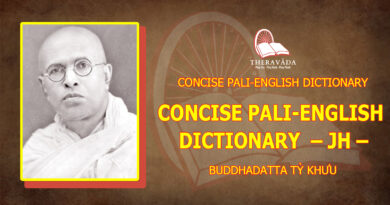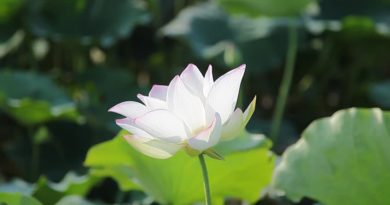THE PATTHANUDDESA DIPANI – CHAPTER 13: KAMMA-PACCAYA
THE PATTHANUDDESA DIPANI – CHAPTER 13: KAMMA-PACCAYA
The relation of kamma is of two kinds: coexistent kamma and asynchronous kamma.
Of these two, all volitions, moral, immoral, and unmoral, which consist of three time-phases, constitute the causal relation of coexistent kamma. Their related things are: All classes of consciousness and their mental concomitants in coexistence with volition; material qualities born of kamma, which arise simultaneously with the rebirth-conception, and material qualities produced by mind during the term of life.
Past moral and immoral volitions constitute the causal relation of asynchronous kamma. Their related things are the thirty-seven classes of mundane resultant consciousness and their mental concomitants, and all the material qualities born of kamma.
Why is kamma so called? It is so called on account of its peculiar function. This peculiar function is nothing but volition (or will) itself, and it dominates every action. When any action of thought, word, or body, takes place, volition (or will) determines, fashions, or causes its concomitants to perform their respective functions simultaneously. For this reason, volition is said to be predominant in all actions. Thus kamma is so called on account of its peculiar function. Or, to define it in another way, kamma is that by which creatures do (or act). What do they do then? They do physical work, vocal work, and mental work. Here, by “physical work” is meant standing, sitting, and so forth; stepping forward and backward, and so on; and even the opening and the shutting of the eyelids. Vocal work means producing vocal sounds. Mental work means thinking wisely or badly, and, in short, the functions of seeing, hearing, and so forth, with the five senses. Thus all the actions of beings are determined by this volition. Therefore it is called kamma.
Sahajata is that which comes into being simultaneously with its related things. Sahajatakamma is a coexistent thing as well as a kamma. Sahajatakamma-paccaya is a causal relation standing (to its effects) by way of coexistent kamma.
Nanakkhanikam is a thing differing in point of time from its effects. That is to say, the time when the volition arises is one, and the time when its effects take place is another; or, in other words, the volition is asynchronous. Hence asynchronous volition is a volition that differs in point of time from its effects. So Nanakkhanikakammapaccaya is a causal relation standing (to its effects) by way of asynchronous kamma. The volition which coexists with the Aryan Path, only at the moment of its ceasing, immediately produces its effect, and so it also is asynchronous.
Here, a moral volition such as predominates in charity, for instance, is causally related to its coexistent mind and mental qualities, together with the material qualities produced by the same mind, by way of coexistent kamma. It is also causally related, by way of asynchronous kamma, to the resultant aggregates of mind and material qualities born of that kamma, which will be brought into existence at a distant period in the future. Thus a volition, which is transmuted into a course of action entailing moral and immoral consequences, is causally related to its related things by way of two such different relations at two different times.
In this asynchronous kamma relation, the kamma signifies quite a peculiar energy. It does not cease though the volition ceases, but latently follows the sequences of mind. As soon as it obtains a favorable opportunity, it takes effect immediately after the dying-thought has ceased, by transmuting itself into the form of an individual in the immediately following existence. But, if it does not obtain any favorable opportunity, it remains in the same latent mode for many hundreds of existences. If it obtains a favorable opportunity, then what is called “sublime kamma” takes effect, upon the next existence in the Brahma-loka, by transmuting itself into the form of a Brahma-deva, and it is so matured that it exhausts itself at the end of this second existence, and does not go any further.
[End of Kamma-Relation]









